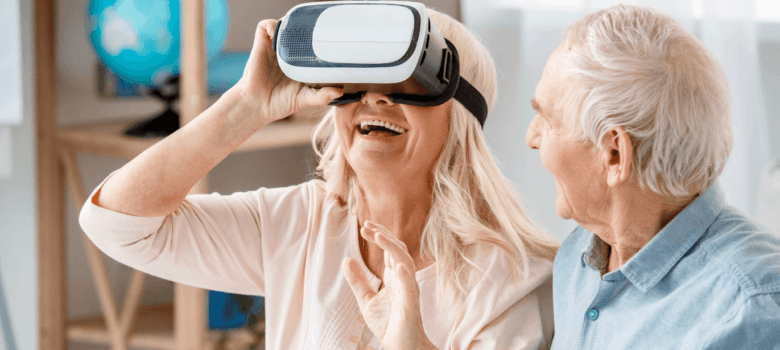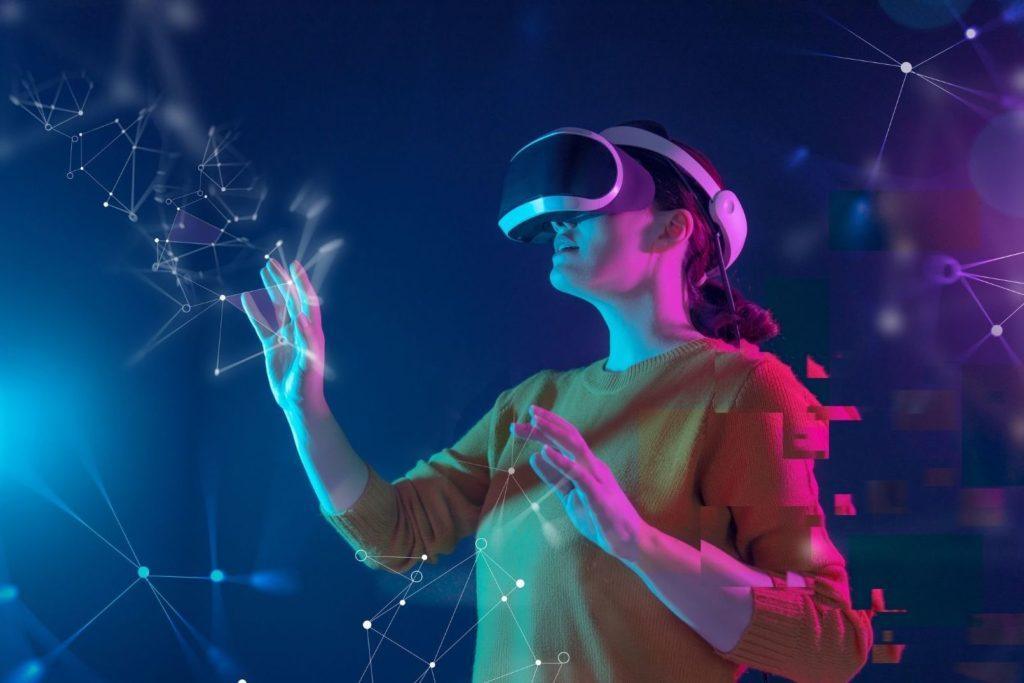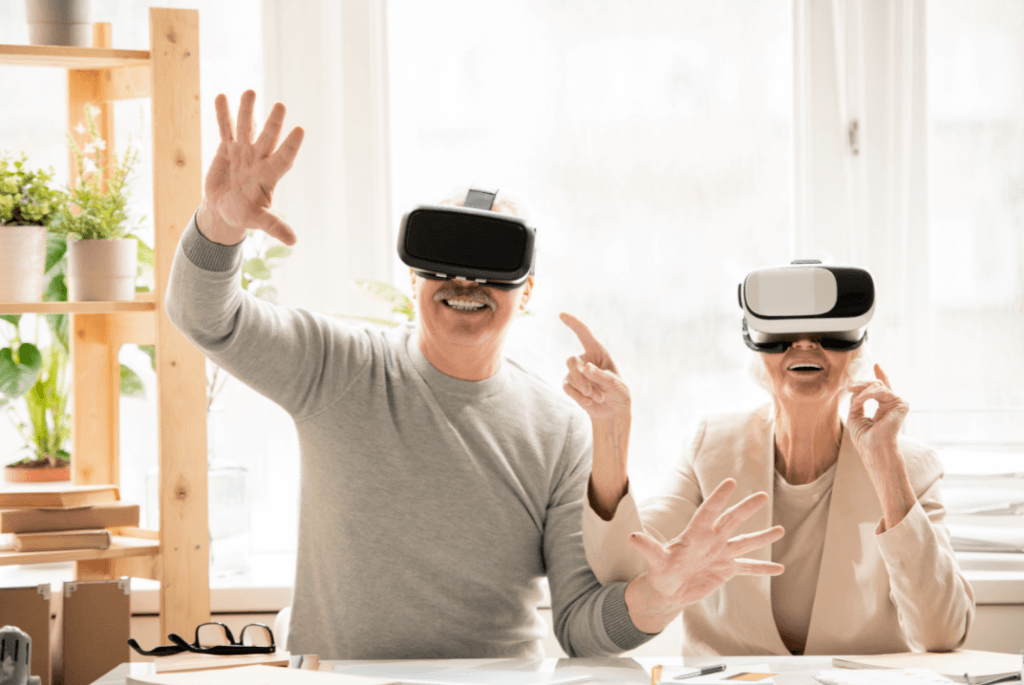

VR Games Could Offer Hope for Delaying Dementia
by Guest Author
Virtual reality games that combine physical activity and brain-training may help slow cognitive decline in older adults, research at Pacific Neuroscience Institute suggests.
Virtual reality exergaming has exploded in popularity in recent years, with more people getting a workout by using PlayStation VR or Oculus headsets and playing games like Beat Saber and Supernatural. Less known is the impact VR exergaming may have on improving cognitive function in older adults.
Growing research, however, suggests VR exergaming, or “gamercising,” may help slow cognitive decline, which could have a major impact on the health and quality of life for seniors.
The National Institute on Aging reports that mild cognitive decline often leads to Alzheimer’s disease or other dementias. Alzheimer’s affects as many as 5.8 million people in the United States, and though there’s no cure, evolving research is helping us better understand how to treat and prevent age-related cognitive impairment.
Virtual reality therapies are known for their physical and mental health benefits. And, as it turns out, remarkable things can happen when the body and mind work together.
What is VR exergaming?

VR exergaming combines a virtual reality environment with a video game. Most VR exergames are delivered in 2D format, but as VR headsets have become more accessible, 3D exergames are also gaining popularity due to a growing interest in improving health and well-being.
Exergaming isn’t new. Research on exercise-oriented gaming dates as far back as the 1980s when VR technology was first being developed. If you’re old enough to remember the Nintendo Power Pad, you may have been among the first to play an exergame.
During the 1990s, a handful of companies developed high-end fitness equipment such as the “Entertainment Exercycle,” a collaboration between Nintendo and Life Fitness, or Cybergear’s Tectrix VR Bike and VRClimber. But these products proved too expensive for consumers and businesses.
By the 2010s, exergaming became synonymous with movement-based video games by Xbox, Playstation, Nintendo Switch, Nintendo Wii and more. These were far more affordable and easier to bring into your home than their predecessors.
The benefits of VR exergaming

A 2021 survey of more than 600 participants shows recreational use of VR, including exergaming, was beneficial for mental and physical well-being during COVID-19 lockdowns and restrictions.
While playing a VR exergame at home is a fun and easy way to exercise, it’s also being increasingly used by medical and rehabilitation professionals, and it offers patients an option for safe exercise at home under minimal supervision.
Ryan Glatt, MS, CPT, NBC-HWC, a personal trainer and board-certified health coach at the Pacific Brain Health Center within the Pacific Neuroscience Institute in Santa Monica, California, realized at a young age that video games like Dance Dance Revolution offered unique mind-body benefits.
“As a kid, I was overweight and suffered a concussion that gave me ADHD,” Glatt said. “I wanted to figure out how I could harness my video game addiction for good.” He said exergaming helped him to lose weight and improve his ADHD symptoms. Fast-forward to adulthood, and Glatt’s passion for gaming morphed into a career.
As a “Fitbrain” trainer at the Pacific Brain Health Center, Glatt combines gaming and fitness with brain health. He works with clinicians and researchers to improve memory function in older adults with mild cognitive impairment, or MCI, by combining physical and cognitive exercises using recumbent bikes and treadmills with 2D tablets or 3D VR headsets. He also incorporates seated or standing VR exercises without equipment and 2D movement exercises without VR.
The Pacific Brain Health Center’s outpatient memory clinic is a high-tech gym for older adults to help prevent and potentially treat cognitive impairment. According to Glatt, Pacific Brain Health is one of the first brain gyms to use VR exergaming for older adults in a clinical setting.
“I started the Fitbrain program four years ago to create — what some people in the literature have called — a serious ‘clinical arcade,'” Glatt said. “It’s a game, it’s fun, but its implications are not just for entertainment, it’s meant to have a therapeutic effect.”
How movement may affect brain health
VR exergaming is showing promise for the prevention of memory loss in research studies. According to Glatt and emerging scientific research, there are potential benefits for dementias like Alzheimer’s and Parkinson’s disease, and neurological conditions like multiple sclerosis.
“When we’re talking about healthy aging, we’re all interested in preventing or slowing cognitive decline,” Glatt said. “And most of the exergaming research has shown us that’s exactly what it can improve.”
According to Glatt, older adults who exergame may see improvements in executive function, the brain’s ability to plan, organize and respond. Other benefits may include improvements in cognition, balance, mood, quality of life, gait and walking speed.
The results are typically dose-dependent, meaning the more you exergame to stimulate cognition, the more brain benefit there is.
“This isn’t a magic pill,” Glatt said. “A lot of people might feel immediate improvements, but to retain the benefits we need repeated exposure, just like with regular exercise.”
How it works
David Merrill, MD, an adult and geriatric psychiatrist and director of the Pacific Brain Health Center, says a synergy exists between the benefits of physical exercise and gaming.

“Physical exercise is probably one if not the most well-validated interventions to improve both general health and also brain health or brain function or both,” Dr. Merrill said.
According to Dr. Merrill, physical exercise works to improve circulation, increase neurogenesis (formation of new brain cells) and enhance the brain’s memory centers in the hippocampus. And when cognitive and physical activities are combined together through gamified elements, Dr. Merrill said there may be enhanced benefits.
A concept known as “dual tasking” combines tasks that could also be performed and measured separately. Dual tasking, according to Dr. Merrill and Glatt, may be responsible for the added cognitive benefit compared to exercise alone.
Dr. Merrill says he’s witnessed overwhelmingly positive results at the memory clinic among older adults with MCI.
“We’re hoping that by having the exergaming experience at the brain gym they’ll take this into real life by increasing activities like gardening, dancing, walking, socializing with friends, or even doing recumbent biking at home while listening to podcasts,” Dr. Merrill said. “We’re seeing that exergaming helps people get an appreciation of the potential benefits of healthy lifestyle habits.”
What the research shows
A growing body of research shows VR exergaming may benefit populations with cognitive impairment or with other neurological diseases or conditions, which may have implications for prevention.
The iPACES protocol asks an older adult and their caregiver or partner to “pedal and play” for six months in the comfort of their own home. Researchers regularly track participants’ progress and monitor their executive functioning via phone and Google Meet.
The 2D exergames feature executive-function challenges that focus on errand-like tasks like trips to the market, post office, dentist or doctor’s office while pedaling along a virtual bike path.
Aside from furthering the research of VR exergaming’s cognitive benefits, iPACES aims to make exercise more enjoyable and engaging for older adults.
Types of exergames and how to access them
Though technological advancements have been made, it may take some time before VR exergames become widely available for older adults with MCI, as more research is still needed.
Some of the tech has evolved to suit the home environment, a notable convenience during the pandemic, but exergaming is not yet recognized by insurance companies for its therapeutic value, making it difficult to access.
Both immersive and non-immersive VR exergames are used at the Pacific Health Center’s memory clinic. Here are a few key differences:
Immersive VR
Immersive VR uses a headset or goggles to transport the user to a 3D virtual environment they interact with.
Some patients might ride a recumbent bike while wearing VR goggles. Dr. Merrill described one game at the memory clinic that involves riding through a virtual space and collecting colored gems with your right and left hands.
“It’s a workout for your body because you’re cycling, but also for your brain because you’re trying to catch these gems and get a high score and win,” Dr. Merrill said. “Older adults really seem to like it — it’s an enjoyable experience that people tend to want to do again.”
Nonimmersive VR
Nonimmersive VR includes a 2D screen the user interacts with. For example, a patient might pedal on a recumbent bike while holding a tablet displaying a 2D virtual environment. You would use the tablet to steer your activity in the direction you want to go, similar to the iPACES pedaler.
A nonimmersive treadmill or elliptical machine might feature a smart screen displaying games that respond to touch, and target reaction time, language and even math skills.
Dr. Merrill believes that VR headsets aren’t always the best option for seniors and that 2D can be safer and more accessible.
“It’s overwhelming for some older adults to give them a headset, so holding a tablet may actually be more tolerable.”
Precautions
Exergames for older adults are typically performed under the supervision of a medical or fitness professional.
At the Pacific Brain Health Center, many patients start on a “cyber cycle” — a recumbent bike with an interactive screen you steer with handles. From there, a patient might progress to a treadmill while wearing VR goggles, secured by a waist strap to stabilize movement as cameras analyze gait.
“It’s all about finding out which one’s appropriate,” Glatt said.
Looking ahead

Although there’s already a direct-to-consumer market for VR exergaming, the tech has yet to reach the masses.
For exergaming to go mainstream, Glatt said that highlighting the wellness features, similar to the updated Apple Watch, could help it reach mass adoption.
As more research emerges and companies continue to develop clinical exergames for older adults, we’ll likely see more people using VR exergaming at home, in rehabilitation settings and in nursing homes. Glatt said that exergames will likely become more immersive, and some could even become available as a smartphone app.
“The idea that research is starting to show that these things can benefit our brains and bodies is what I would call the ‘killer app’ for any of these niche technologies,” Glatt said.
And with eventual FDA approval, Glatt said that VR exergaming could potentially be regarded as a treatment for Alzheimer’s or other dementias.
“That’s the future I want to contribute to for older adults,” Glatt said. “‘Oh, you’re having a memory problem? Let me write you a prescription for a video game.'”
The iPACES clinical trial is still accepting enrollments. For more info visit myipaces.org. If you live in the Los Angeles area, an iPACES pedaler is available for a test drive at the Pacific Brain Health Center.
Santa Monica: 310-582-7641
Article adapted from original publication on CNET.com.
About David Merrill, MD, PhD

David A. Merrill, MD, PhD, is an adult and geriatric psychiatrist with double-board certification by the American Board of Psychiatry and Neurology. He is director of the Pacific Brain Health Center at Pacific Neuroscience Institute. Dr. Merrill has worked for several decades with patients suffering the behavioral health sequelae of age-related neurodegenerative disorders such as Alzheimer’s disease and Parkinson’s disorder. His more recent clinical and research work have expanded to include patients with history of head trauma, tumor, and stroke.
About Ryan Glatt, MS, CPT, NBC-HWC

Ryan Glatt, MS, CPT, NBC-HWC, is a personal trainer and board-certified health coach with a specialty focus in brain health with over a decade of experience in the health & fitness industry. He currently works alongside clinicians and researchers to implement cognitively-enhanced and comprehensive exercise and lifestyle interventions at the Pacific Brain Health Center in Santa Monica, California.
Related Links:
Last updated: June 14th, 2022
